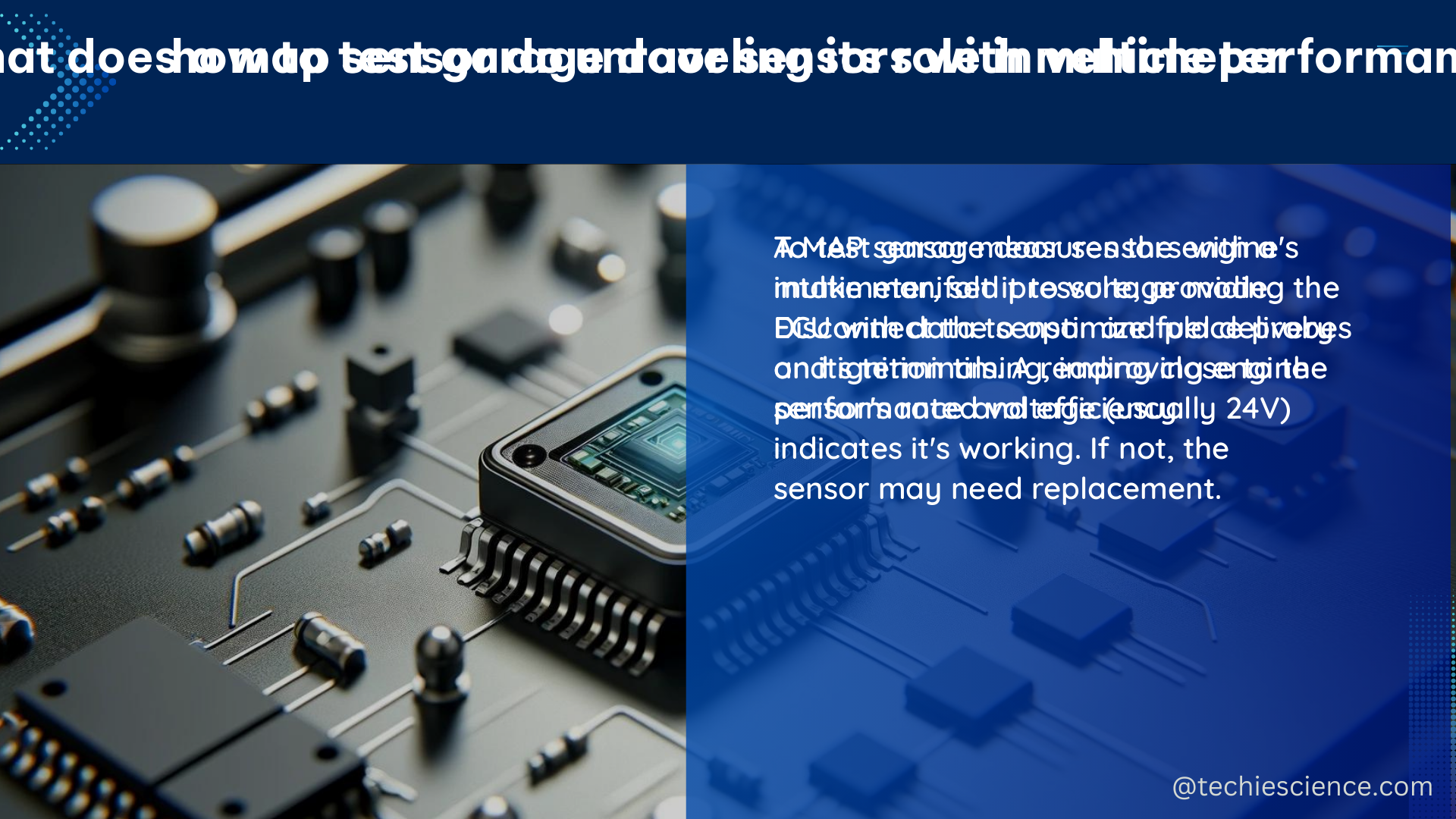A Manifold Absolute Pressure (MAP) sensor is a critical component in a vehicle’s engine management system, responsible for measuring the intake manifold pressure and providing real-time data to the Engine Control Unit (ECU). This data is essential for optimizing engine performance, fuel efficiency, and emissions control.
Understanding the MAP Sensor’s Function
The MAP sensor works by continuously monitoring the pressure inside the engine’s intake manifold and converting this information into an electrical signal. This signal is then sent to the ECU, which uses it, along with data from other sensors, to determine various engine parameters such as:
- Ignition Timing: The ECU adjusts the ignition timing based on the manifold pressure to ensure optimal combustion and prevent engine knocking.
- Fuel Injection: The ECU uses the MAP sensor data to calculate the correct amount of fuel to be injected into the cylinders, ensuring a proper air-fuel ratio for efficient combustion.
- Turbocharger/Supercharger Control: In turbocharged or supercharged engines, the MAP sensor data is used to control the boost pressure, preventing over-boosting and engine damage.
- Exhaust Gas Recirculation (EGR) Control: The MAP sensor data helps the ECU regulate the EGR system, which recirculates a portion of the exhaust gases back into the intake manifold to reduce emissions.
Absolute Pressure vs. Gauge Pressure

It’s important to understand the difference between absolute pressure and gauge pressure when discussing MAP sensors. Absolute pressure is the pressure measured relative to a perfect vacuum, while gauge pressure is the pressure measured relative to atmospheric pressure.
- Absolute Pressure: A MAP sensor measures the absolute pressure inside the intake manifold, which can range from near-vacuum (during engine deceleration) to slightly above atmospheric pressure (during full throttle).
- Gauge Pressure: In contrast, a boost sensor measures the gauge pressure, which is the pressure above or below atmospheric pressure. Boost sensors are commonly used in turbocharged or supercharged engines to monitor the boost pressure.
For example, a 3-bar MAP sensor will read approximately 1.01325 bar (14.7 psi) at sea level, as this is the standard atmospheric pressure. In a turbocharged engine, a boost sensor may read 0.5 bar (7.25 psi) of boost pressure above atmospheric pressure.
Diagnosing MAP Sensor Issues
When a MAP sensor fails, it can trigger a diagnostic trouble code (DTC) in the ECU. Some common DTC codes related to a faulty MAP sensor include:
- P0105: MAP sensor circuit issue
- P0106: MAP sensor performance issue
- P0107: MAP sensor circuit low input voltage issue
- P0108: MAP sensor circuit high input voltage issue
- P0109: MAP sensor circuit intermittent issue
MAP sensors can fail due to various reasons, such as:
- Contamination: Dirt, debris, or oil can accumulate on the sensor, affecting its performance.
- Extreme Vibrations: The constant vibrations in the engine bay can cause the MAP sensor to fail over time.
- Overheating: Exposure to high temperatures, such as those found in the engine compartment, can damage the sensor’s internal components.
Symptoms of a faulty MAP sensor may include:
- Poor fuel economy
- Slow acceleration
- Rough idle
- Surging
- Stalling
- Lack of power
- Hesitation on acceleration
- Backfiring through the intake
- Overheating
Diagnosing and Troubleshooting MAP Sensor Issues
To diagnose a faulty MAP sensor, you’ll need an automotive diagnostic scanner, such as the Innova 5210 or 5610. These scanners can read and interpret engine fault codes, sensor voltage, and other relevant data. Here’s a step-by-step guide to troubleshooting a MAP sensor issue:
- Scan for DTCs: Use the diagnostic scanner to check for any MAP sensor-related DTCs. This will provide a starting point for your investigation.
- Inspect the MAP Sensor: Visually inspect the MAP sensor for any signs of damage, contamination, or loose connections.
- Check the Sensor Voltage: Use the diagnostic scanner to measure the MAP sensor’s voltage output. The voltage should vary based on the manifold pressure, typically ranging from around 1 volt (low pressure) to 5 volts (high pressure).
- Perform a Vacuum Test: Apply a known vacuum to the MAP sensor and verify that the voltage output changes accordingly. This will help you determine if the sensor is functioning correctly.
- Check for Wiring Issues: Inspect the wiring harness and connections between the MAP sensor and the ECU for any signs of damage or corrosion.
- Replace the MAP Sensor: If the sensor is faulty, replace it with a new one and retest the system.
By following these steps, you can accurately diagnose and troubleshoot any issues related to the MAP sensor, ensuring your vehicle’s engine management system is operating at its best.
Conclusion
The Manifold Absolute Pressure (MAP) sensor is a critical component in a vehicle’s engine management system, providing the ECU with real-time data on the intake manifold pressure. This information is essential for optimizing engine performance, fuel efficiency, and emissions control. Understanding the MAP sensor’s function, the difference between absolute and gauge pressure, and the common issues associated with it is crucial for effectively diagnosing and troubleshooting any related problems.
References:
- Using an OBD2 Scanner to Diagnose a Faulty MAP Sensor – Innova
- MAP Sensor Design Pt. 1 – 27WON Performance
- Manifold Absolute Pressure Sensor – KLM Performance
- Making sense of your sensors: MAP sensor – Delphi Technologies

The lambdageeks.com Core SME Team is a group of experienced subject matter experts from diverse scientific and technical fields including Physics, Chemistry, Technology,Electronics & Electrical Engineering, Automotive, Mechanical Engineering. Our team collaborates to create high-quality, well-researched articles on a wide range of science and technology topics for the lambdageeks.com website.
All Our Senior SME are having more than 7 Years of experience in the respective fields . They are either Working Industry Professionals or assocaited With different Universities. Refer Our Authors Page to get to know About our Core SMEs.